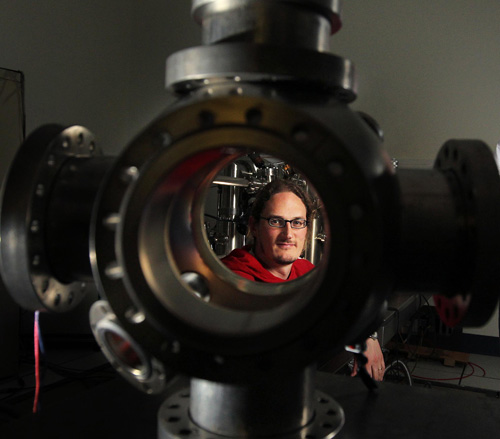New Nanomaterials Unlock Future Electronic and Energy Technologies
Posted on: 04 February 2011
A new way of splitting layered materials to give atom thin “nanosheets” has been discovered. This has led to a range of novel two-dimensional nanomaterials with chemical and electronic properties that have the potential to enable new electronic and energy storage technologies. The collaborative* international research led by the Centre for Research on Adaptive Nanostructures and Nanodevices (CRANN), Trinity College Dublin, Ireland, and the University of Oxford has been published in this week’s Science. The research has been funded by Science Foundation Ireland.
The scientists have invented a versatile method for creating these atom thin nanosheets from a range of materials using common solvents and ultrasound, utilising devices similar to those used to clean jewellery. The new method is simple, fast, and inexpensive, and could be scaled up to work on an industrial scale.
“Of the many possible applications of these new nanosheets, perhaps the most important are as thermoelectric materials. These materials, when fabricated into devices, can generate electricity from waste heat. For example, in gas-fired power plants, approximately 50% of energy produced is lost as waste heat while for coal and oil plants the figure is up to 70%. However, the development of efficient thermoelectric devices would allow some of this waste heat to be recycled cheaply and easily, something that has been beyond us, up until now,” explained Professor Jonathan Coleman, Principal Investigator at CRANN and the School of Physics, Trinity College Dublin who led the research along with Dr Valeria Nicolosi in the Department of Materials at the University of Oxford.

Professor Jonathan Coleman, Principal Investigator at CRANN and the School of Physics.
This research can be compared to the work regarding the two-dimensional material graphene, which won the Nobel Prize in 2010. Graphene has generated significant interest because when separated into individual flakes, it has exceptional electronic and mechanical properties that are very different from those of its parent crystal, graphite. However, graphite is just one of hundreds of layered materials, some of which may enable powerful new technologies.
Coleman’s work will open up over 150 similarly exotic layered materials – such as Boron Nitride, Molybdenum disulfide, and Bismuth telluride – that have the potential to be metallic, semiconducting or insulating, depending on their chemical composition and how their atoms are arranged. This new family of materials opens a whole range of new “super” materials.
For decades researchers have tried to create nanosheets from layered materials in order to unlock their unusual electronic and thermoelectric properties. However, previous methods were time-consuming, laborious or of very low yield and so unsuited to most applications.
“Our new method offers low-costs, a very high yield and a very large throughput: within a couple of hours, and with just 1 mg of material, billions and billions of one-atom-thick nanosheets can be made at the same time from a wide variety of exotic layered materials,” explained Dr Nicolosi, from the University of Oxford.
These new materials are also suited for use in next-generation batteries – “supercapacitors” – which can deliver energy thousands of times faster than standard batteries, enabling new applications such as electric cars. Many of these new atomic layered materials are very strong and can be added to plastics to produce super-strong composites. These will be useful in a range of industries from simple structural plastics to aeronautics.
About CRANN:
CRANN is the Centre for Research on Adaptive Nanostructures and Nanodevices at Trinity College Dublin, Ireland. CRANN, established in 2004 is a Science Foundation Ireland funded nanoscience research institute based at Trinity College Dublin, Ireland. Nanoscience is a research discipline which underpins key innovations in many sectors. CRANN, with over 250 researchers, carries out research in partnership with over 60 companies and universities from over 30 countries around the world.
* The research paper is titled ‘Two-dimensional nanosheets produced by liquid exfoliation of layered materials’, and published in the 4 February edition of the journal Science.
Trinity in the News:
- Irish Times
- Science
- New York Times
- Bio-medicine
- World news
- ABC Science
- WNFLam.com
- World News Australia
- AIB
